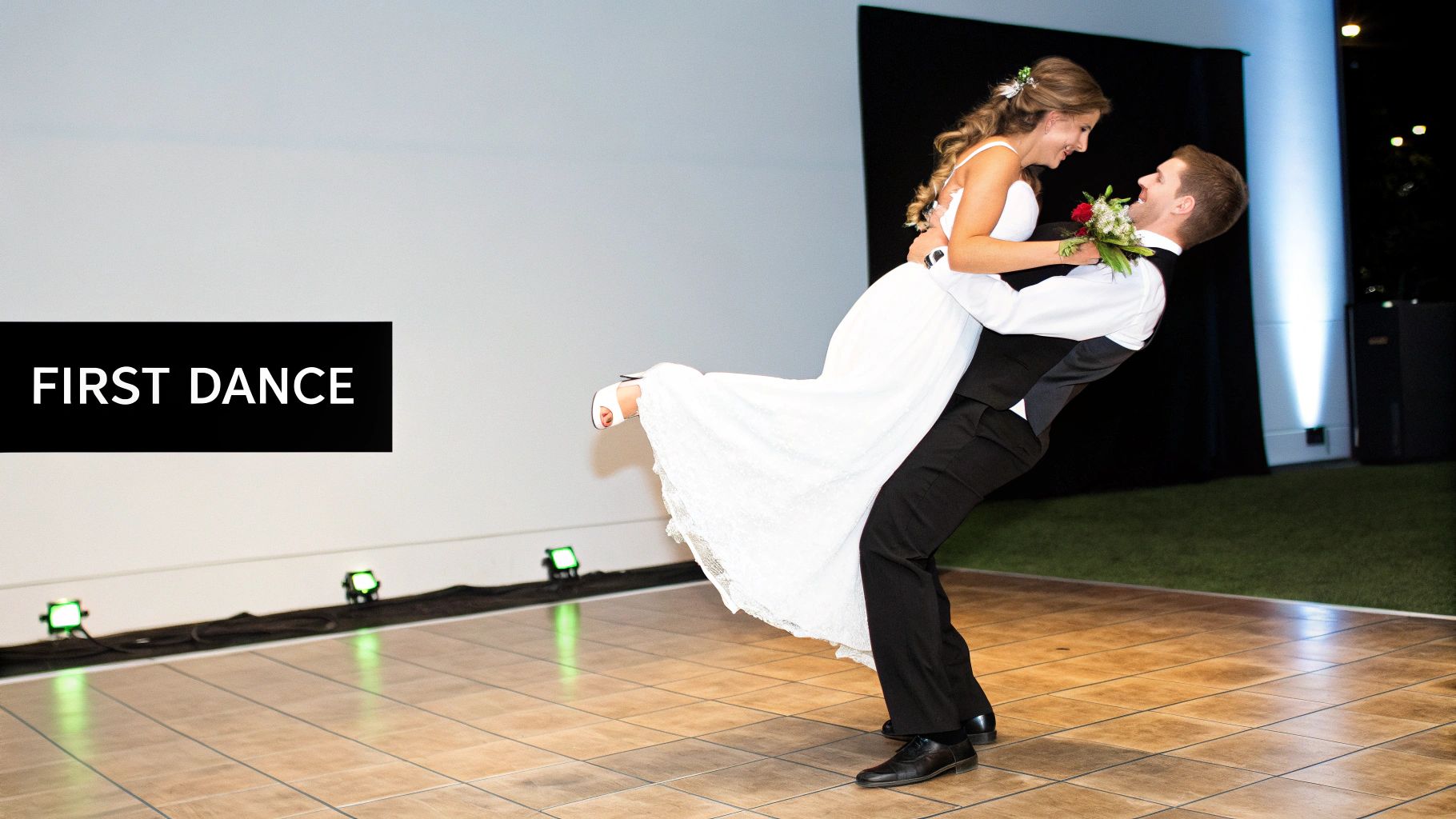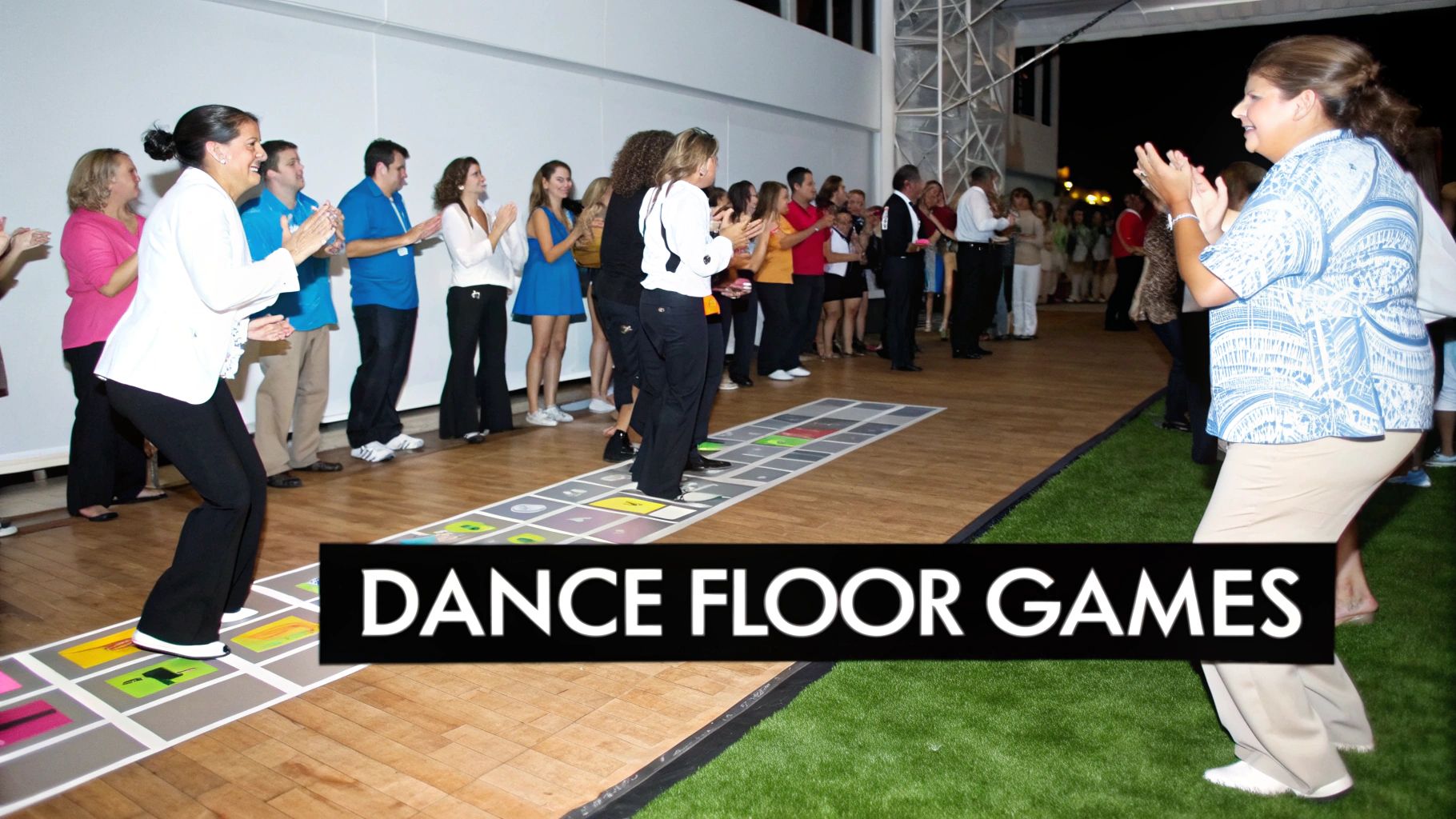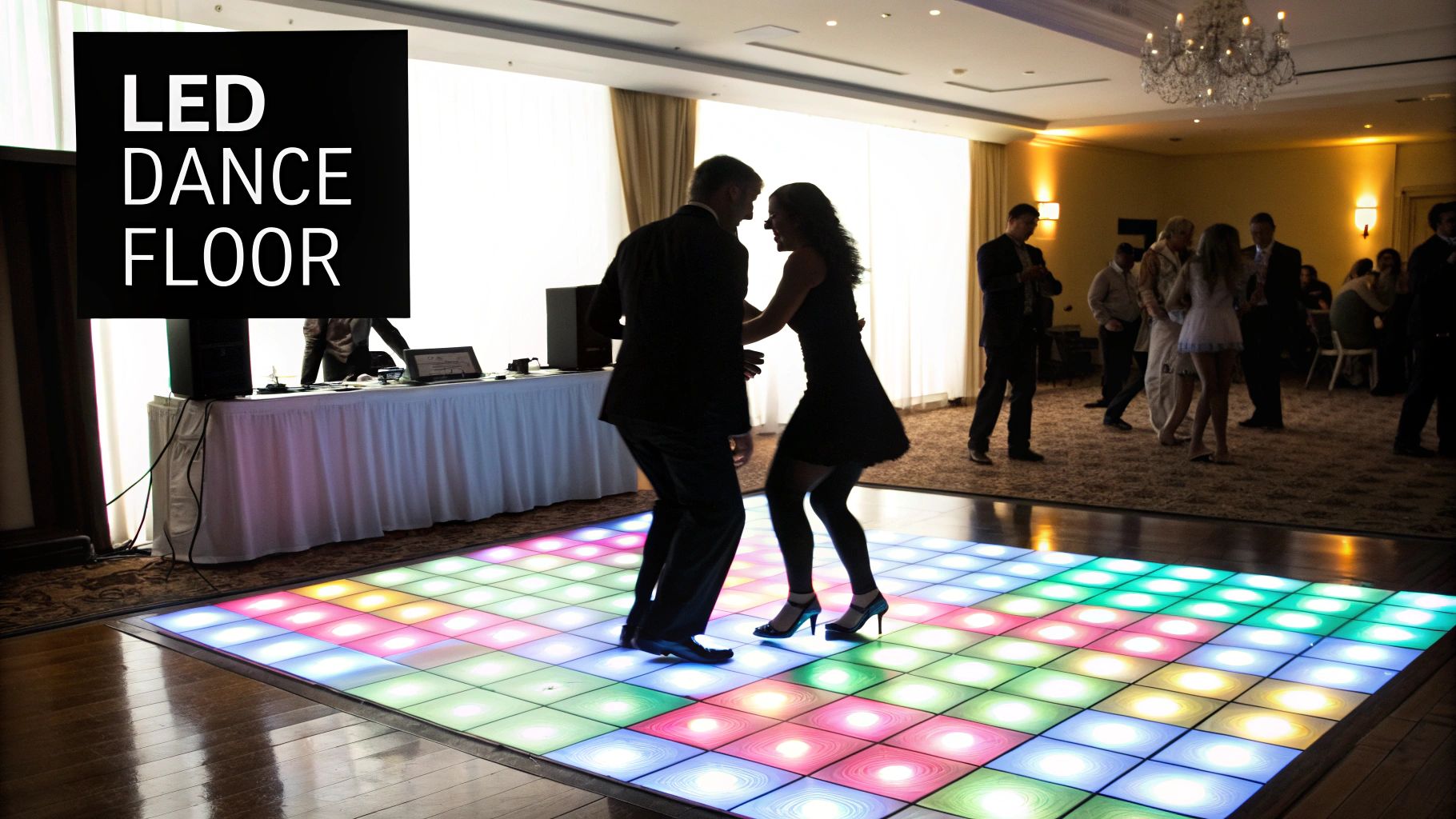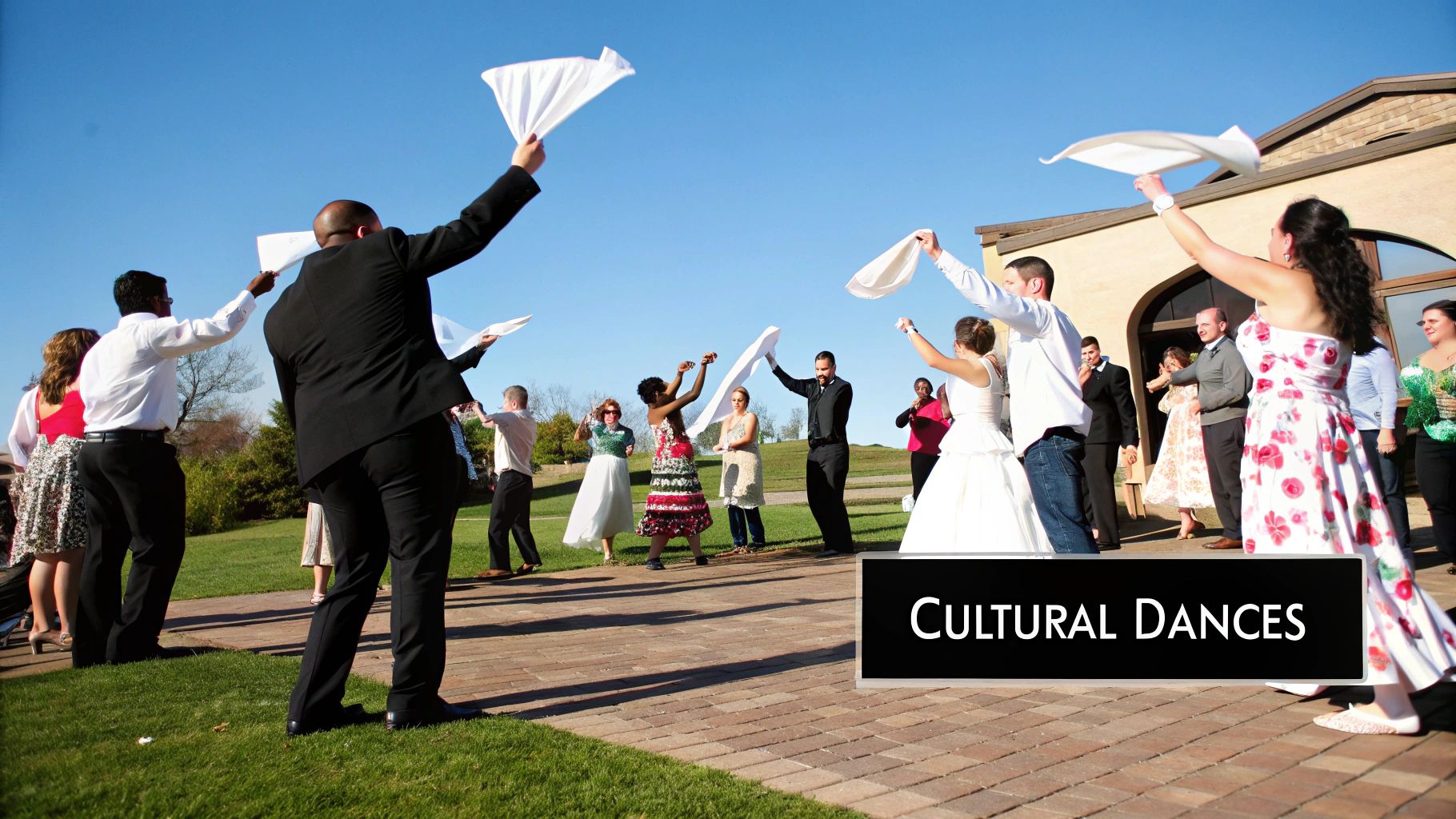Top Tips for Wedding Reception Dancing to Wow Your Guests
- Chase Gillmore

- May 24
- 16 min read
Get the Party Started: Wedding Reception Dance Ideas
Want unforgettable wedding reception dancing? This list offers seven creative ideas to energize your celebration and engage every guest. Discover how personalized dance instruction, interactive games, and unique floor layouts can transform your reception. Explore options from classic first dance choreography to exciting live music performances and cultural traditions. Whether you're planning a wedding, corporate event, or private party, these ideas will help create a vibrant and memorable dance floor experience.
1. First Dance Choreography
First dance choreography elevates the traditional wedding reception slow dance into a captivating performance. This carefully planned routine, set to a song with special meaning to the couple, serves as the elegant kickoff to the evening's wedding reception dancing. Routines can range from a simple, polished waltz to an elaborate showcase incorporating lifts, spins, and dips, surprising and delighting guests. It's a beautiful opportunity for the newlyweds to express their love story through movement and create a truly memorable moment.

A choreographed first dance offers several features and benefits. The dance routine is personalized and tailored to the couple's skill level and comfort, ensuring they feel confident and enjoy the experience. Couples can select a song that holds personal significance, further enhancing the emotional impact of the dance. Professional instruction is readily available through many dance studios, offering expert guidance and support. Moreover, the choreography provides a structured and elegant way to transition into the open dancing portion of the reception. Professionally filmed, these choreographed dances often become cherished keepsakes and highly shareable content for social media. Think of memorable first dances like Justin Timberlake and Jessica Biel's choreographed performance to "Senorita" or the timeless elegance of Prince William and Kate Middleton's waltz. Viral videos showcasing couples surprising guests with dance medleys, transitioning from traditional slow songs to upbeat numbers, highlight the engaging potential of this approach to wedding reception dancing.
While the benefits are numerous, couples should also consider the potential drawbacks. Choreography requires an investment of time for lessons and practice leading up to the wedding, which can add to an already busy schedule. This can be particularly stressful for couples with limited dance experience. Professional choreography and lessons can also add to wedding costs. Finally, the pressure to perform perfectly in front of guests can create anxiety.
To ensure a smooth and enjoyable experience, start lessons at least 3-4 months before the wedding date. Choose a song with a manageable tempo that complements your skill level. Practice in shoes and attire similar to what you’ll wear on the wedding day to get accustomed to movement and flow. Keep the routine under 3 minutes to maintain guest engagement. And importantly, have a backup plan for any complex moves in case of pre-wedding jitters or dress limitations on the big day. The rise in popularity of choreographed first dances can be attributed to several factors, including Dancing with the Stars professionals offering wedding choreography services, social media platforms like TikTok and Instagram showcasing viral wedding dances, and celebrity weddings featured in entertainment magazines. This trend has solidified the choreographed first dance as a memorable and engaging element of modern wedding receptions.
For those looking for guidance on choosing the perfect first dance song, learn more about First Dance Choreography. This approach to wedding reception dancing is a fantastic way to personalize your celebration and create a lasting impression on your guests.
2. Interactive Dance Floor Games
Interactive dance floor games are a fantastic way to boost wedding reception dancing and ensure everyone feels comfortable joining in the fun. These structured activities, often led by the DJ or MC, offer a welcome break from traditional dancing and encourage participation from guests of all ages and dancing abilities. These organized moments inject a playful energy into the reception, transforming the dance floor into a hub of laughter and shared experiences. They work by providing simple, guided dances with clear instructions, often incorporating competitive elements or props to enhance the experience.

From the classic Shoe Game, where the newlyweds answer questions about their relationship by holding up the corresponding shoe, to the ever-popular Anniversary Dance, which celebrates long-lasting love and creates a touching moment on the dance floor, the options are diverse and adaptable. Other favorites include conga lines that weave their way through the reception venue, and limbo contests that bring out everyone's competitive side. These games offer a structured approach to wedding reception dancing, providing a comfortable entry point for guests who might be hesitant to hit the dance floor otherwise. Progressive activities, starting with low-key participation and building up to more energetic dances, help build momentum and keep the celebration flowing. Learn more about Interactive Dance Floor Games to get some additional inspiration for your wedding reception or event (Learn more about Interactive Dance Floor Games).
Features and Benefits:
Guided Group Dances: Easy-to-follow instructions make it simple for everyone to participate.
Competitive Elements: Friendly competition adds an element of excitement and encourages engagement.
Props and Visual Cues: Enhance the fun and make participation more accessible.
Progressive Activities: Build energy and momentum throughout the reception.
Pros:
Encourages participation from guests of all ages and dance skill levels.
Creates shared memories and fantastic photo opportunities.
Helps overcome initial reluctance to dance.
Provides structure and momentum to the reception timeline.
Cons:
Some games can feel forced or cheesy if not executed well.
Not all guests enjoy structured participation activities.
Can take time away from free dancing if overused.
May require additional props or preparation.
Tips for Successful Implementation:
Discuss your preferred games with your DJ/MC beforehand.
Schedule interactive elements strategically, such as during lulls in energy.
Test games with your wedding party to ensure they flow smoothly.
Offer small prizes to winners to boost participation.
Keep instructions clear and concise for all guests to understand.
Interactive dance floor games deserve a place in this list because they provide a fun and engaging way to maximize wedding reception dancing and ensure a memorable experience for all. They offer a structured, inclusive approach that caters to a wide range of guests, transforming the dance floor into a vibrant hub of activity and celebration. They are also becoming increasingly popular as couples and event planners seek creative ways to enhance the entertainment and encourage interaction.
3. Dance Floor Technology Enhancements
Want to elevate your wedding reception dancing from enjoyable to unforgettable? Dance floor technology enhancements can transform a traditional dance floor into a vibrant, immersive experience. These additions go beyond standard venue lighting, utilizing cutting-edge technology like programmable LEDs, projection mapping, and synchronized lighting systems to create a truly spectacular atmosphere. These innovations not only encourage guests to hit the dance floor but also provide captivating visual entertainment for everyone, even those who prefer to sit and enjoy the show.

Imagine your monogram projected onto the dance floor, morphing into intricate patterns that pulse with the beat of the music. Or perhaps a projection-mapped first dance where the floor beneath you transforms into a starry night sky or a cascading waterfall. Fog and special effects can be coordinated with specific songs to create dramatic moments, while interactive elements respond to dancer movements, adding another layer of engagement. Technology can enhance the atmosphere on your dance floor. Think about special effects, projections, or even creative lighting for dance floors to truly set the mood. Source: Creative Lighting for Dance Floor Wedding Ideas from 1021 Events These features create a premium, nightclub-like atmosphere that impresses guests and makes for stunning wedding photos and videos. They can even transform ordinary venues into extraordinary spaces, adding a touch of magic to your celebration.
While these enhancements offer a range of benefits, there are also considerations to keep in mind. The most significant is the added cost, which can be substantial depending on the complexity of the setup. These technologies also require technical expertise and setup time, and may not be compatible with all venue electrical systems. Finally, some effects may be distracting or overwhelming for certain guests, so it's important to strike a balance.
Pros:
Creates a premium nightclub atmosphere
Provides visual stimulation for all guests
Customizable to match wedding themes and colors
Enhances wedding photos and videos
Transforms ordinary venues
Cons:
Significant additional cost
Requires technical expertise and setup
Potential venue compatibility issues
Some effects may be overwhelming
Tips for Success:
Book specialized vendors 6-8 months in advance.
Confirm venue policies regarding special effects.
Schedule a technical walkthrough with your venue and lighting team.
Create a lighting cue sheet for key moments.
Consider a simpler setup for older guests during dinner.
These technologies have been popularized by celebrity weddings and high-production events, but they are increasingly accessible for couples looking to add a unique touch to their wedding reception dancing. By carefully planning and coordinating these enhancements, you can create an unforgettable dance floor experience that will have your guests talking long after the last song plays.
4. Cultural Dance Traditions
Infusing your wedding reception with cultural dance traditions is a beautiful way to honor your heritage, create lasting memories, and entertain your guests. This involves incorporating choreographed or spontaneous dances specific to the couple's cultural backgrounds, adding a unique and personal touch to the wedding reception dancing. These traditions often involve family members and can become powerful moments of intergenerational connection, sharing a piece of your history with loved ones. It's a fantastic opportunity to educate guests about different cultures while celebrating the union of two families.

Cultural dance traditions can manifest in many forms. Authentic music and choreography are crucial, transporting guests to another time and place. This might involve traditional attire changes, special props, and often includes participation from family and the wider cultural community. Some couples even incorporate teaching elements into the dances, allowing guests from all backgrounds to join in the fun and become a part of the celebration. Examples include the lively Jewish Horah chair dance, the Greek Kalamatianos circle dance with its flowing handkerchiefs, vibrant Indian Bollywood-style family performances, the energetic Irish Céilí with called instructions, or the playful Mexican La Vibora (snake dance) weaving through the reception with a tablecloth.
This approach to wedding reception dancing deserves a place on this list because it moves beyond standard reception activities. It offers something unique, memorable, and deeply personal. The benefits are numerous: it honors family heritage, creates powerful emotional moments, provides unique entertainment, offers educational value for guests, and adds richness and depth to the celebration.
However, incorporating cultural traditions also requires careful planning. Coordination with family members and cultural groups is essential to ensure authentic representation. Timing within the reception schedule needs careful consideration, and providing context and explanations for guests unfamiliar with the traditions can enhance their appreciation. For multicultural couples, balancing multiple traditions can require extra thought and sensitivity.
Tips for Success:
Consult with Elders: Speak with elder family members to ensure authentic representation and incorporate meaningful details.
Provide Context: Offer brief explanations of the traditions in your wedding programs or through MC announcements.
Practice Makes Perfect: Consider scheduling a quick practice session before the wedding for key participants.
Encourage Participation: Arrange for simplified versions of the dances that encourage broader guest participation.
Coordinate with Music: Discuss cultural elements with your DJ or band to ensure appropriate music transitions and create a seamless flow.
Cultural dance traditions have become increasingly popular thanks to cultural dance troupes performing at weddings, multicultural wedding planners specializing in tradition integration, social media and wedding blogs showcasing diverse celebrations, and, most importantly, the dedication of family elders who maintain and teach these beautiful customs. By incorporating these elements, you can transform your wedding reception dancing into a truly unforgettable celebration of love, heritage, and connection.
5. Live Music Dance Performances
Elevating your wedding reception dancing to the next level can be achieved with the mesmerizing addition of live music dance performances. This involves integrating professional dancers into your reception, offering captivating entertainment that goes beyond the typical DJ or wedding band. These performances can serve as standalone acts, interspersed between guest dancing, or even become interactive experiences that encourage everyone to join in the fun. This approach injects an air of sophistication and excitement into the celebration, creating an unforgettable experience for you and your guests.
These aren't just impromptu dances; these are carefully choreographed routines performed by skilled professionals. Styles can range from classic ballroom and Latin dances to high-energy hip-hop and contemporary pieces. Imagine ballroom champions showcasing their elegant moves between dinner courses, or a surprise flash mob erupting from amongst your guests, pulling everyone onto the dance floor. Some couples even opt for unique acts, like aerial silk performers suspended above the dance floor or cultural dance troupes showcasing traditions related to their heritage. The possibilities are as diverse as your imagination. Learn more about Live Music Dance Performances
Features and Benefits:
Professional-Level Entertainment: Live dance performances inject a "wow" factor into your reception, leaving a lasting impression on your guests.
Variety of Styles: From traditional ballroom and Latin dances to modern hip-hop and contemporary routines, you can choose a style that resonates with your taste and wedding theme. You can even incorporate specialty acts like aerial performers, flash mobs, or cultural dance troupes.
Interactive Options: Consider performers who offer brief lessons following their show, encouraging your guests to learn some basic steps and join the fun. This is particularly effective with styles like salsa or tango.
Personalized Performances: Reflect your unique story by selecting dancers who specialize in a style you love, or even performers from the studio where you took dance lessons.
Natural Breaks: The performances create seamless transitions in your reception timeline, providing a break for guests between dancing sets and allowing for other activities, like cake cutting or speeches.
Pros & Cons:
Pros: Impresses guests, creates natural breaks, inspires guest dancing, adds a luxury element, reflects the couple's interests.
Cons: Significant additional cost, requires appropriate floor space and staging, needs coordination with vendors and timeline, may reduce time available for guest dancing.
Tips for Seamless Implementation:
Book Early: Secure your desired performers at least 6 months in advance, especially if you're planning your wedding during peak season.
Strategic Scheduling: Consider scheduling performances during dinner, while the couple takes sunset photos, or between other key events.
Venue Considerations: Ensure your venue can accommodate any technical requirements, such as sufficient ceiling height for aerial acts or a suitable floor type for specific dance styles. Check for adequate changing areas for performers as well.
Guest Interaction: Look for dancers who also offer brief lessons to get your guests involved in the dancing.
Photography Coordination: Inform your photographer about the planned performances so they can capture these special moments effectively.
The popularity of shows like "Dancing with the Stars" and "So You Think You Can Dance" has made professional dance performances a sought-after element for weddings. Luxury wedding planners are increasingly incorporating theatrical elements into receptions, and social media influencers are showcasing elaborate wedding entertainment, further fueling the trend. Live music dance performances truly deserve a place on this list for their ability to transform wedding reception dancing from ordinary to extraordinary. They offer a unique blend of artistry, entertainment, and interactive fun that will create lasting memories for everyone involved.
6. Dance Floor Alternative Layouts
Traditional wedding reception dancing often revolves around a single, central dance floor. However, alternative dance floor layouts are gaining popularity, offering a dynamic and engaging experience for wedding reception dancing. These creative approaches move beyond the standard setup, enhancing guest flow, encouraging more participation, and creating unique spatial dynamics. Instead of confining all the action to one area, alternative layouts utilize multiple dance areas, varying levels, and unconventional shapes to transform the entire reception space. This method deserves its place on this list because it adds a unique dimension to the celebration, catering to a wider range of guest preferences and maximizing the use of the venue.
Alternative layouts involve strategically placing smaller dance floors throughout the venue, creating designated zones for dancing. These can include:
Multiple Smaller Dance Areas: Instead of one large dance floor, create several smaller ones throughout the venue, perhaps with different music genres or themes in each.
Elevated or Multi-Level Platforms: Adding levels creates visual interest and can designate specific areas for different types of dancing or activities.
Unconventional Shapes: Circular, geometric, or free-form dance floors add a unique design element and can be tailored to the venue’s layout.
Indoor-Outdoor Transitions: Seamlessly extend the dance floor from inside the venue to an outdoor patio or terrace, creating a flow between spaces.
Temporary Installations: Modular dance floors or temporary platforms that can be reconfigured during the reception add an element of surprise and adaptability.
Examples of Successful Implementation:
A 360-degree central dance floor with the band or DJ positioned in the middle, allowing guests to surround the musicians.
Satellite dance areas with different music styles or themes, catering to diverse musical tastes. A dedicated disco area, a chill-out lounge with ambient music, and a main dance floor with the wedding band all offer variety.
A dance floor that extends from the indoor reception space to an outdoor terrace, allowing guests to enjoy the fresh air while dancing.
A raised platform dance area that creates a performance-like atmosphere, highlighting the dancing couples.
Tips for Implementation:
Venue Consultation: Consult your venue early on about structural possibilities, weight limitations, and available power outlets for lighting and sound.
Guest Flow: Consider guest movement patterns when planning multiple dance areas, ensuring easy access to bars, restrooms, and seating.
Strategic Lighting: Use lighting to clearly define each dance space and create distinct atmospheres.
Coordinated Sound: If using multiple dance areas with different music, ensure the sound systems are coordinated to prevent competing music or sound bleed.
Clear Signage: Include clear signage or make announcements about the unique dance floor layouts so guests can easily find and utilize them.
Proximity to Amenities: Place dance floors strategically near bars and seating areas to encourage participation and prevent them from feeling isolated.
Pros:
Accommodates diverse preferences: Offers options for guests who prefer quiet conversation as well as those who want to dance the night away.
Improved flow: Creates natural movement throughout the venue and prevents bottlenecks.
Reduces overcrowding: Distributes guests across multiple areas, preventing a single crowded dance floor.
Maximizes interaction: Smaller, more intimate dance areas can encourage greater interaction among guests.
Optimizes venue space: Makes effective use of unusual or challenging venue layouts.
Cons:
Increased costs: May require additional lighting, sound equipment, and flooring rentals.
Photography challenges: Can complicate photography coverage, requiring the photographer to move between different areas.
Potential for split energy: Poorly implemented layouts can fragment the crowd and diminish the overall energy.
Logistical complexity: More complex to manage for DJs/bands and requires careful coordination.
Popularized By: Alternative dance floor layouts have been popularized by innovative architectural design firms specializing in event spaces, celebrity wedding planners like Preston Bailey and David Tutera, experiential event companies, and social media wedding trends emphasizing unique spatial experiences. These layouts represent a shift towards creating more personalized and engaging wedding reception dancing experiences.
7. Personalized Dance Instruction
Want to get everyone on the dance floor at your wedding reception? Personalized dance instruction offers a fun, engaging way to achieve just that. This unique approach brings professional dance instructors right to your reception to guide guests through various dance styles, making wedding reception dancing accessible to everyone, regardless of their skill level. It creates an interactive experience that goes beyond the traditional reception format and fosters shared learning and memories.
This service works by having professional instructors present during a designated time at the reception. They provide brief, engaging lessons in specific dance styles. These styles can be customized to match the couple's musical preferences or the event's theme, ensuring a cohesive and personalized experience. Instruction is often progressive, building skills throughout the evening. Many instructors also incorporate demonstration performances, adding an element of entertainment and inspiration.
For example, if you're having a Latin-themed wedding, salsa instructors could teach basic steps before the Latin music sets begin. A barn or rustic-themed wedding might feature country line dancing, while a vintage or Great Gatsby-themed event could offer swing dance lessons. Even traditional folk dances or ballroom styles like the waltz can be incorporated, offering a touch of elegance and formality. Imagine your guests confidently waltzing after a quick lesson before the first dance!
Why Choose Personalized Dance Instruction?
This approach deserves a spot on this list because it transforms wedding reception dancing from a potentially intimidating activity into an inclusive, shared experience. It provides structure and encourages participation from guests who might otherwise shy away from the dance floor. The simple, achievable steps taught during the lessons build confidence, and the interactive nature of the activity creates unique memories.
Pros:
Makes dancing accessible for guests with limited experience.
Creates an interactive activity beyond the traditional reception format.
Provides structure and encourages participation.
Builds confidence through simple steps.
Creates unique, shared memories.
Cons:
Additional cost for professional instruction.
Requires dedicated time in the reception schedule.
Not all guests may want to participate.
Needs coordination with the DJ/band for music selection.
Requires sufficient floor space.
Tips for Success:
Timing is Key: Schedule instruction early in the reception before guests get tired.
Tailor the Difficulty: Brief instructors on guest demographics so they can tailor the difficulty level appropriately.
Spread the Word: Market the instruction in advance so guests know to expect it and come prepared to participate.
Experience Matters: Select instructors with wedding experience who understand the casual environment.
Keep it Short and Sweet: Lessons should be brief (15-20 minutes) and focus on fun rather than perfect technique.
Continued Support: Have instructors remain available to help struggling dancers throughout the evening.
Learn more about Personalized Dance Instruction This link provides additional information on customizing your music and entertainment, which goes hand-in-hand with personalized dance instruction.
The rising popularity of personalized dance instruction can be attributed to factors like dance studios offering wedding packages (think Arthur Murray and Fred Astaire), the influence of shows like Dancing with the Stars, and the incorporation of cultural dance instruction at destination wedding resorts. Even social dance organizations are promoting community dancing at events. This trend reflects a desire to create a more interactive and inclusive celebration, ensuring that wedding reception dancing is an enjoyable experience for all.
7 Key Wedding Dance Strategies Compared
Tip/Strategy | Implementation Complexity 🔄 | Resource Requirements 💡 | Expected Outcomes 📊 | Ideal Use Cases 💡 | Key Advantages ⭐ |
|---|---|---|---|---|---|
First Dance Choreography | Medium to High – needs lessons and practice | Professional instructor, rehearsal time, cost | Memorable, personalized moment; structured start | Couples wanting a meaningful, showcase dance | Personalized, unique storytelling through dance |
Interactive Dance Floor Games | Low to Medium – guided games led by DJs/MCs | Props, DJ/MC coordination, some prep | Increased guest participation and energy | Receptions needing icebreakers and inclusive fun | Encourages all guests to join, fun and engaging |
Dance Floor Technology Enhancements | High – technical setup and equipment needed | Specialized vendors, lighting & effects gear | Visually impressive, immersive atmosphere | Luxury weddings seeking wow-factor | Premium experience, customizable & photogenic |
Cultural Dance Traditions | Medium – coordination and cultural knowledge | Traditional music, props, attire, practice | Emotional, educational, heritage honoring moments | Multicultural weddings or those honoring roots | Deep cultural significance; unique entertainment |
Live Music Dance Performances | High – professional performers, staging needs | Professional dancers, space, coordination | High-energy, impressive entertainment | Large-scale, luxury, or high-budget weddings | Professional, memorable entertainment break |
Dance Floor Alternative Layouts | Medium to High – complex venue design | Multiple floors, lighting, sound adjustments | Improved flow, diverse participation | Venues with large or unique spaces | Enhances guest experience, prevents overcrowding |
Personalized Dance Instruction | Medium – onsite instructors and scheduling | Professional instructors, dedicated time | Inclusive, confidence-building, interactive | Weddings wanting guest engagement and learning | Accessible dance, fun for all skill levels |
Creating a Memorable Wedding Reception Dance Experience
From the electrifying first dance to the last song of the night, wedding reception dancing sets the tone for an unforgettable celebration. This article explored seven key elements to elevate your dance floor, from personalized choreography and interactive games to innovative technology and honoring cultural traditions. By carefully considering these aspects, you can create a vibrant and inclusive atmosphere where every guest feels encouraged to join the fun. Mastering these concepts ensures a dynamic and engaging experience that will be remembered long after the last dance. Whether you envision a sophisticated waltz or a high-energy party, prioritizing your wedding reception dancing transforms your special day into a truly personalized and joyous occasion.
For a truly unforgettable wedding reception dancing experience, consider Uptown Drive, Austin's premier wedding and event band. They specialize in creating a vibrant and personalized atmosphere with high-energy performances and interactive live band karaoke. Visit Uptown Drive today to learn more about how they can make your wedding reception an unforgettable celebration.

Comments